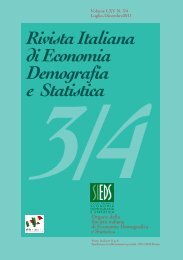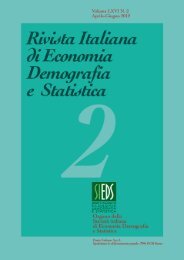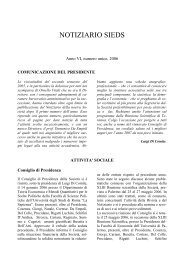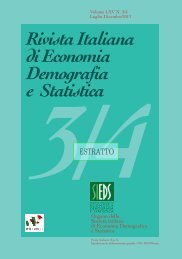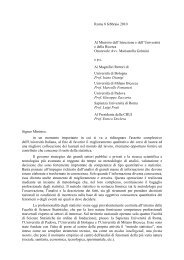rivista italiana di economia demografia e statistica - Sieds
rivista italiana di economia demografia e statistica - Sieds
rivista italiana di economia demografia e statistica - Sieds
Create successful ePaper yourself
Turn your PDF publications into a flip-book with our unique Google optimized e-Paper software.
32<br />
Volume LXIII nn. 3-4 – Luglio-Dicembre 2009<br />
welfare.<br />
In this study the idea is to study the dynamic of the inequality of the income<br />
<strong>di</strong>stribution also in the time <strong>di</strong>mension by considering macrocohorts. A<br />
macrocohort can be defined as a group with fixed membership, formed by<br />
in<strong>di</strong>viduals, that can be identified as they show up in the survey (Deaton 1985).<br />
Grouping in<strong>di</strong>viduals accor<strong>di</strong>ng to a common characteristic gives the possibility to<br />
observe macrocohorts over time. We grouped the households on eight in<strong>di</strong>pendent<br />
cross-sections of Italian housholds between 1997-2004 on the basis of the head's<br />
year of birth. We defined eleven groups by a five-years band except for the first<br />
and the last macrohorts, where the age brackets are extended due to the small cell<br />
size 3 . We decided to focus our attention on those macrocohorts with the haed aged<br />
20-79 in 1997.<br />
After grouping data, we adjusted expen<strong>di</strong>ture accor<strong>di</strong>ng to the Carbonaro's<br />
equivalence scale, this allows us to compare households of <strong>di</strong>fferent size, netted out<br />
of economies of scale effects. If we consider expen<strong>di</strong>ture levels as proxy for<br />
income, we are able to compute the Gini index for macrocohorts and year and<br />
estimate the contribution of several factors to income <strong>di</strong>spersion. In the next<br />
section we will present the methodology.<br />
3. The Shapley value decomposition<br />
The Shapley value decomposition approach is a regression-based methodology<br />
that permits to quantify the impact on inequality of several causal determinants<br />
(Shorrocks, 1982, 1999). The idea is to specify an income generating model that<br />
includes what we consider contributory factors and subsequetly decomposes the<br />
Gini index isolating the effect of each factor. The methodology can be used to<br />
decompose any inequality index using any income general funtional form.<br />
Shorrocks (1999) proposed a general application of the Shapley value method to<br />
decompose income inequality, this procedure treats symmetrically all factors and<br />
leads to an exact ad<strong>di</strong>tive decomposition of inequality index into contributory<br />
factors. The methodology has the advantage that groups of factors may be<br />
considered as a single entity without affecting their total contribution.<br />
3 It is necessary that each macrocohort size is sufficienty large in order to obtain consistent<br />
estimates.Verbeek and Nijman (1992) showed that fairly large cohort sizes, i.e. 100<br />
in<strong>di</strong>viduals, are needed to validly ignore the cohort nature of the data.



